In the pursuit of a gleaming and protected automobile finish, car enthusiasts and detailing enthusiasts alike often face a crucial decision: should you apply wax before ceramic coating? The world of automotive care offers a myriad of options for preserving and enhancing your vehicle’s appearance, with both waxing and ceramic coating playing pivotal roles.
However, understanding the relationship between these two techniques is key to making informed choices about your car’s paintwork. In this exploration, we will unravel the intricacies of whether to wax before applying a ceramic coating, shedding light on the advantages, potential pitfalls, and best practices that can help you achieve that enviable, showroom-quality shine while safeguarding your vehicle’s exterior.
Why you should wax before ceramic coating
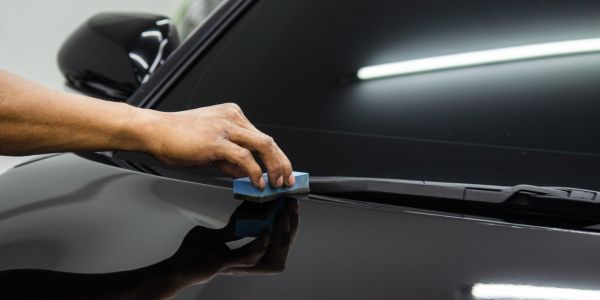
Waxing before applying a ceramic coating can offer several benefits when it comes to protecting and enhancing your vehicle’s paintwork. Here are some reasons why waxing before ceramic coating is a recommended practice:
Enhanced Gloss and Shine:
Waxing your car before applying a ceramic coating can provide an extra layer of gloss and shine to the paint. The wax creates a smooth and reflective surface that enhances the overall appearance of your vehicle.
Improved Hydrophobic Properties:
Many waxes have hydrophobic properties, meaning they repel water. This can help in the maintenance of the ceramic coating, as water and contaminants are less likely to adhere to the surface, making it easier to clean and maintain.
Additional UV Protection:
Wax contains UV inhibitors that can offer an extra layer of protection against the harmful effects of the sun’s ultraviolet (UV) rays. This can help prevent paint fading and oxidation over time.
Increased Depth of Color:
Waxing can bring out the depth and richness of your car’s paint color. It can make your vehicle’s color appear more vibrant and attractive.
Enhanced Durability:
While ceramic coatings are highly durable, adding a layer of wax before applying the ceramic coating can provide an extra level of protection. Wax acts as a sacrificial layer, taking the brunt of daily wear and tear, which can prolong the life of the ceramic coating beneath.
Smoother Surface:
Waxing your car can fill in minor imperfections, such as tiny swirl marks or micro-scratches, creating a smoother surface for the ceramic coating to bond with. This can result in a more even and effective application of the ceramic coating.
Ease of Application:
Some detailers prefer to wax the car first because it’s a familiar and straightforward process. This can help create a clean and well-prepared surface before applying the ceramic coating.
It’s important to note that not all waxes are compatible with ceramic coatings. Ensure that the wax you choose is specifically designed for use with ceramic coatings and follow the manufacturer’s guidelines. Additionally, proper surface preparation, including decontamination and polishing if necessary, is essential before applying both wax and ceramic coating to achieve the best results.
Ultimately, while waxing before ceramic coating is beneficial, it’s just one part of the overall process of protecting and enhancing your vehicle’s paint. A well-maintained and properly applied ceramic coating can provide long-lasting protection and a stunning finish.
The benefits of waxing before ceramic coating
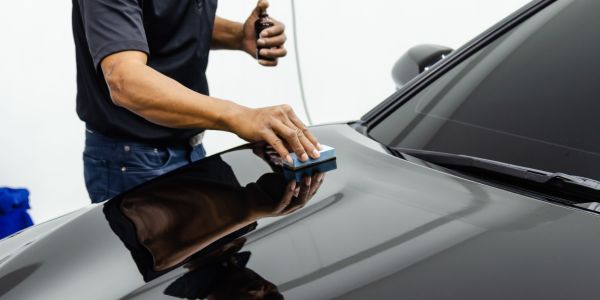
Waxing before applying a ceramic coating can offer several advantages, enhancing the overall protection and appearance of your vehicle’s paintwork. Here are some key benefits of waxing before ceramic coating:
Enhanced Gloss and Shine:
Waxing creates a smooth and glossy surface that enhances the depth and brilliance of your car’s paint. The added layer of wax can provide an even more impressive shine when the ceramic coating is applied over it.
Extra Layer of Protection:
Wax acts as an additional barrier against environmental contaminants, including bird droppings, tree sap, and road tar. It serves as a sacrificial layer, absorbing and repelling these contaminants, which can help preserve the integrity of the ceramic coating underneath.
Improved Hydrophobic Properties:
Many waxes have hydrophobic properties, causing water to bead and roll off the surface. This not only keeps your car cleaner but also complements the hydrophobic qualities of ceramic coatings, making it easier to maintain the finish.
UV Protection:
Wax often contains UV inhibitors that help shield your car’s paint from the sun’s harmful ultraviolet (UV) rays. This added layer of UV protection can prevent paint fading and oxidation over time.
Enhanced Durability:
While ceramic coatings are highly durable, they can benefit from the added protection provided by wax. Wax can extend the life of the ceramic coating by acting as a buffer against minor abrasions and environmental aggressors.
Smoothing Surface Imperfections:
Wax can fill in minor imperfections such as swirl marks, fine scratches, and minor paint defects. This creates a smoother canvas for the ceramic coating to bond to, resulting in a more uniform and effective application.
Simplified Maintenance:
The combination of wax and ceramic coating can make maintenance easier. The wax repels contaminants, while the ceramic coating simplifies cleaning by preventing dirt and grime from adhering strongly to the surface.
Cost-Effective Solution:
Wax is generally more affordable than ceramic coating, making it a cost-effective way to enhance the paint’s appearance and protection before applying the more permanent ceramic coating.
Ease of Application:
Wax is a familiar and straightforward product to apply for many car enthusiasts and detailers. It can be easily applied using traditional methods, making it an accessible step in the preparation process.
It’s important to note that not all waxes are compatible with ceramic coatings. Ensure that the wax you choose is designed for use with ceramic coatings and follow the manufacturer’s recommendations. Additionally, thorough surface preparation, including decontamination and potential paint correction, is essential to maximize the benefits of both waxing and ceramic coating.
In summary, waxing before ceramic coating offers numerous benefits, including enhanced gloss, added protection, improved hydrophobic properties, UV resistance, and easier maintenance. This combination can result in a stunning and long-lasting finish for your vehicle.
How to wax your car before ceramic coating
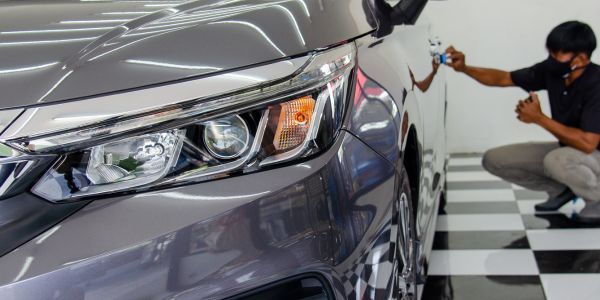
Waxing your car before applying a ceramic coating is a recommended step to enhance the protection and appearance of your vehicle’s paintwork. Here’s a step-by-step guide on how to wax your car before ceramic coating:
Materials You’ll Need:
- Car wash soap
- Microfiber wash mitt or sponge
- Two buckets (one for soapy water and one for rinse water)
- Grit guard (optional, but recommended)
- Hose or pressure washer
- Microfiber towels or drying towel
- Automotive wax compatible with ceramic coatings
- Wax applicator pads or microfiber applicator pads
- Soft microfiber buffing towels
- Isopropyl alcohol (IPA) solution (for surface preparation, if needed)
Wash Your Car:
Start by thoroughly washing your car using a high-quality car wash soap. Ensure that you remove all dirt, grime, and contaminants from the paint surface. Use a microfiber wash mitt or sponge for washing.
Rinse Well:
Rinse your car thoroughly with a hose or pressure washer to remove all soap residue. Make sure the surface is completely clean and free of soap.
Drying:
Use a microfiber towel or a drying towel to dry your car. Pat the surface gently to avoid scratching the paint. Make sure the car is entirely dry before proceeding.
Surface Inspection:
Inspect the paint for any remaining contaminants, swirl marks, or minor imperfections. If necessary, you can use a clay bar to remove embedded contaminants or perform paint correction.
Isopropyl Alcohol (IPA) Wipe (Optional):
If you suspect any wax residue or want to ensure a completely clean surface, you can perform an IPA wipe. Mix a solution of 50% isopropyl alcohol and 50% water in a spray bottle. Spray it onto the paint and wipe it off with a clean microfiber towel. This step is optional but can improve the bond of the ceramic coating.
Apply the Wax:
Choose a high-quality automotive wax that is compatible with ceramic coatings. Follow the manufacturer’s instructions for application.
Use wax applicator pads or microfiber applicator pads to apply a thin, even layer of wax to one section of the car at a time. Work in small, manageable areas.
Allow the Wax to Haze:
Let the wax sit and haze over for the recommended time specified by the wax manufacturer. This typically ranges from a few minutes to around 15-20 minutes.
Buff the Wax:
Using a soft microfiber buffing towel, gently buff away the wax in a circular motion. Ensure that you remove all residue and reveal a glossy finish.
Repeat for the Entire Car:
Continue the waxing process, section by section, until you’ve covered the entire car.
Final Inspection:
Conduct a final inspection to ensure that the wax has been evenly applied and thoroughly buffed.
Now, your car’s paint is protected with a layer of wax that enhances its shine and provides additional protection. Allow the wax to cure fully according to the manufacturer’s instructions before proceeding with the ceramic coating application. Waxing before ceramic coating can help optimize the results of the ceramic coating and provide a stunning, long-lasting finish for your vehicle.
The best products to use for waxing before ceramic coating
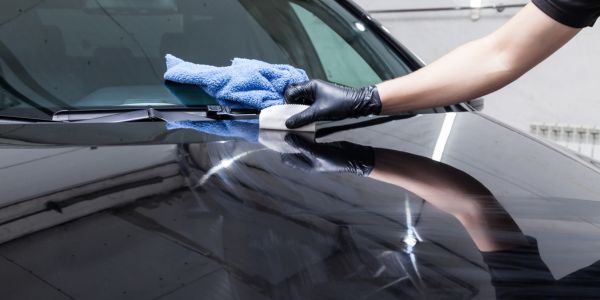
Choosing the right products for waxing before applying a ceramic coating is crucial to achieving the best results. Here are some recommended products to consider for this process:
Car Wash Soap:
- Start with a high-quality car wash soap to clean your vehicle thoroughly before waxing. Look for a pH-balanced soap that won’t strip existing wax or ceramic coatings.
Microfiber Wash Mitt or Sponge:
- Use a soft microfiber wash mitt or sponge to wash your car. Microfiber is gentle on the paint and helps minimize the risk of scratching.
Grit Guard (Optional):
- A grit guard placed at the bottom of your wash bucket can help prevent dirt and debris from being reintroduced onto your wash mitt, reducing the risk of scratches during washing.
Car Drying Towel:
- Invest in a high-quality microfiber car drying towel to dry your vehicle thoroughly without leaving streaks or water spots.
Automotive Wax:
- Choose a high-quality automotive wax that is compatible with ceramic coatings. Look for a synthetic or hybrid wax that provides lasting protection and a deep shine. Some popular wax brands include:
- Meguiar’s
- Mothers
- Chemical Guys
- Collinite
- P21S
Wax Applicator Pads or Microfiber Applicator Pads:
- Use specialized wax applicator pads or microfiber applicator pads to apply the wax evenly and smoothly. These pads help control the amount of product applied and prevent excessive buildup.
Microfiber Buffing Towels:
- Soft, high-quality microfiber buffing towels are essential for removing excess wax and achieving a glossy finish without scratching the paint.
Isopropyl Alcohol (IPA):
- An IPA solution can be used for surface preparation if you want to ensure the paint is entirely clean before applying wax. Mix a solution of 50% isopropyl alcohol and 50% water in a spray bottle.
Remember that the compatibility of your wax with the ceramic coating is essential. Some ceramic coating manufacturers may recommend specific wax brands or types that work best with their products, so it’s a good idea to check with the manufacturer or consult the product documentation for any specific recommendations.
Additionally, follow the manufacturer’s instructions for each product you use, including the wax and any surface preparation steps, to ensure the best possible results when waxing before applying a ceramic coating. Proper preparation and product selection are key to achieving a long-lasting, high-gloss finish on your vehicle.
How often you should wax before ceramic coating
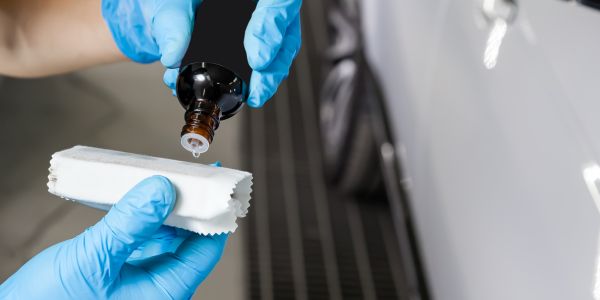
The frequency at which you should wax your vehicle before applying a ceramic coating can vary depending on several factors, including your driving habits, environmental conditions, and the quality of the wax and ceramic coating you’re using. However, here are some general guidelines to consider:
Prep Work:
Before applying a ceramic coating, it’s crucial to thoroughly clean and decontaminate your vehicle’s paint. This includes washing, clay barring, and potentially using a paint polish or compound to remove any imperfections. Waxing is typically done after this prep work.
Initial Waxing:
Many experts recommend applying a high-quality carnauba wax or synthetic wax as a base layer before applying a ceramic coating. This provides an extra layer of protection and enhances the shine. You should wax your car shortly before applying the ceramic coating, usually within a few days to a week.
Maintenance Waxing:
After the ceramic coating is applied, it forms a durable and long-lasting protective layer on the paint. You generally do not need to wax the car again immediately after applying the ceramic coating. In fact, it’s essential to allow the ceramic coating to cure properly, which can take several days to a few weeks.
Ongoing Maintenance:
Once the ceramic coating is fully cured, which depends on the specific product you’re using (follow the manufacturer’s instructions), you can consider periodic waxing to maintain the appearance and protection. How often you should wax your car after ceramic coating depends on factors like:
Driving conditions:
If you frequently drive in harsh conditions, such as areas with heavy road salt, excessive dirt, or industrial pollution, you may need to wax more often.
Exposure to the elements:
Vehicles that are exposed to the sun’s UV rays, rain, and other environmental factors may require more frequent waxing to maintain their appearance.
Quality of the wax:
High-quality waxes tend to last longer and provide better protection. If you’re using a premium wax, you may not need to apply it as often.
Water beading and sheeting:
Pay attention to how water behaves on your vehicle’s surface. If you notice that water no longer beads or sheets off the paint as effectively as it did when the ceramic coating was first applied, it may be time to apply a maintenance wax.
As a general guideline, some enthusiasts recommend waxing your car every 2-3 months after ceramic coating, but this can vary widely based on the factors mentioned above. Always refer to the specific instructions provided by the ceramic coating and wax manufacturers for the best guidance on maintenance for your particular products.
The signs that you need to wax before ceramic coating
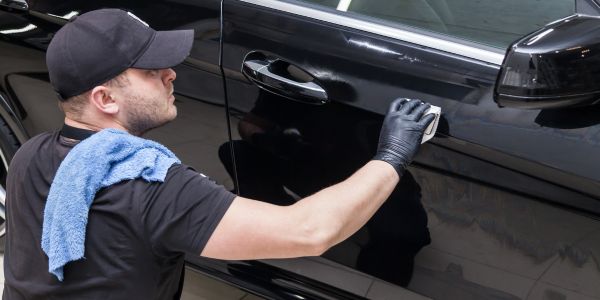
Waxing before applying a ceramic coating is a common step in the preparation process to ensure the best possible bond and longevity of the ceramic coating. Here are some signs that indicate you should consider waxing your vehicle before applying a ceramic coating:
- Lack of Shine: If your vehicle’s paint has lost its luster and no longer exhibits a deep, glossy shine, applying a wax can temporarily enhance its appearance. Waxing can fill in minor imperfections and provide a temporary protective layer.
- Swirl Marks and Light Scratches: If you notice swirl marks, fine scratches, or minor paint imperfections on your vehicle’s surface, a good-quality wax can help mask these issues and improve the overall appearance. However, keep in mind that wax is a temporary solution, and for long-term correction, you may need to use a paint polish or compound.
- Water Behavior: Observe how water behaves on your vehicle’s surface. If water doesn’t bead up effectively or doesn’t sheet off the paint as it should, it might be a sign that your paint needs some protection. Wax can temporarily improve water beading and sheeting.
- Contaminants and Pollution: If your vehicle is exposed to contaminants such as tree sap, bird droppings, road tar, or industrial fallout, these substances can adhere to the paint and damage it over time. Wax can create a barrier that makes it easier to remove such contaminants without harming the paint.
- Oxidation: Older vehicles or vehicles that have been exposed to harsh environmental conditions may show signs of paint oxidation, which can make the paint appear dull and faded. While wax won’t reverse oxidation, it can temporarily improve the appearance and provide some protection.
- Temperature Changes: If you live in an area with significant temperature fluctuations, your vehicle’s paint can expand and contract, potentially causing minor paint imperfections or micro-cracks. Wax can help fill these imperfections and provide some protection against temperature-related damage.
- Before Ceramic Coating: As part of the preparation process for applying a ceramic coating, it’s common to apply a high-quality wax as a base layer. This helps ensure that the paint surface is clean, smooth, and well-protected before the ceramic coating is applied. Waxing just before the ceramic coating application can help ensure a better bond and longevity of the coating.
Keep in mind that waxing is a temporary solution to improve the appearance and protection of your vehicle’s paint. For long-term protection and enhanced durability, the ceramic coating is the primary product to rely on. Always follow the manufacturer’s recommendations and instructions for both the wax and ceramic coating products you use to achieve the best results.
The risks of not waxing before ceramic coating

While waxing before applying a ceramic coating is not an absolute requirement, there are some potential risks and downsides to consider if you choose not to wax your vehicle before applying a ceramic coating:
- Bonding Issues: One of the primary reasons to wax before applying a ceramic coating is to ensure proper bonding of the ceramic coating to the paint surface. Ceramic coatings adhere better to a clean and smooth surface. If your paint has contaminants, oxidation, or minor imperfections, the ceramic coating may not bond as effectively, potentially leading to reduced durability and longevity.
- Surface Imperfections: Ceramic coatings are excellent at locking in the current condition of the paint. If you skip the waxing step and apply a ceramic coating directly to the paint, any swirl marks, light scratches, or minor imperfections present on the surface will be sealed in by the ceramic coating. This means that those imperfections will still be visible after the coating is applied.
- Reduced Gloss and Shine: Waxing before applying a ceramic coating can enhance the gloss and shine of your vehicle’s paint. If you skip this step, your vehicle may not achieve the same level of depth and brilliance in its appearance. Wax can fill in minor imperfections and enhance the paint’s overall aesthetic.
- Contaminant Resistance: Wax provides a temporary barrier against contaminants like tree sap, bird droppings, and road tar. Without this barrier, contaminants may adhere directly to the ceramic coating or the paint beneath it, making them more difficult to remove and potentially causing damage over time.
- Potential for Water Spotting: Ceramic coatings can be more prone to water spotting than waxed surfaces. While ceramic coatings do repel water effectively, any remaining water droplets can leave behind mineral deposits that may be more difficult to remove without wax protection.
- Maintenance Challenges: Without the additional layer of wax, you may find it more challenging to maintain the appearance of your vehicle. Regular washing and care may be required to prevent contamination and maintain a glossy finish.
In summary, while it’s possible to apply a ceramic coating directly to the paint without waxing, doing so can lead to reduced bonding effectiveness, the preservation of surface imperfections, and potentially a less glossy appearance. To maximize the benefits of a ceramic coating and ensure long-term durability, many professionals recommend thoroughly preparing the paint surface, which often includes cleaning, decontaminating, polishing, and applying a high-quality wax as a base layer before applying the ceramic coating. Following the manufacturer’s recommendations and industry best practices will help you achieve the best results with your ceramic coating application
FAQs about waxing before ceramic coating
Here are some frequently asked questions (FAQs) and answers about waxing before applying a ceramic coating:
Do I need to wax my car before applying a ceramic coating?
It’s generally recommended to wax your car before applying a ceramic coating, but it’s not an absolute requirement. Waxing helps ensure a clean, smooth, and protected surface for the ceramic coating to bond to, maximizing its effectiveness and durability.
Can I apply a ceramic coating immediately after waxing?
No, you should not apply a ceramic coating immediately after waxing. You should wait a few days to a week after waxing to allow the wax to cure and the surface to be properly prepped before applying the ceramic coating.
What type of wax should I use before ceramic coating?
Use a high-quality carnauba or synthetic wax that is free of fillers and additives. These waxes provide a clean and smooth surface for the ceramic coating. Avoid using products labeled as “cleaner waxes” or “all-in-one” products as they may contain fillers that can hinder ceramic coating adhesion.
Can I use a spray wax or quick detailer before applying a ceramic coating?
It’s generally best to use a traditional paste or liquid wax before applying a ceramic coating for more thorough protection and bonding. Spray waxes and quick detailers are often used for maintenance after ceramic coating application.
What happens if I don’t wax before applying a ceramic coating?
Skipping the waxing step may lead to reduced bonding effectiveness of the ceramic coating, the preservation of surface imperfections, and potentially a less glossy appearance. It can also make it more challenging to maintain the vehicle’s appearance.
Can I apply a ceramic coating over an existing wax layer?
It’s not recommended to apply a ceramic coating over an existing wax layer. The wax may interfere with the ceramic coating’s ability to bond properly to the paint surface. You should strip the wax before applying the ceramic coating.
How long should I wait after waxing to apply a ceramic coating?
Wait at least a few days to a week after waxing before applying a ceramic coating. This allows the wax to cure and ensures that the surface is clean and prepared for the ceramic coating application.
Can I apply a ceramic coating myself, or should I have it done professionally?
You can apply a ceramic coating yourself if you have the necessary tools, products, and experience. However, professional detailers often have the expertise and equipment to ensure a flawless application. If you’re unsure or want the best results, consider consulting with a professional.
How often should I wax my vehicle after applying a ceramic coating?
The frequency of waxing after ceramic coating depends on factors like driving conditions, exposure to contaminants, and the quality of the ceramic coating. Generally, you may need to wax every 2-3 months or as needed to maintain appearance and protection.
Can I use any brand of wax before a ceramic coating, or should I use the same brand as the ceramic coating?
It’s not necessary to use the same brand of wax as the ceramic coating. However, using products from reputable brands known for quality and compatibility can provide peace of mind. Always follow the specific instructions provided by the ceramic coating and wax manufacturers for best results.
Conclusion
The decision to wax before applying a ceramic coating to your vehicle depends on your goals and the condition of your car’s paint. While waxing is not an absolute necessity, it offers several advantages that can enhance the effectiveness and durability of the ceramic coating. Waxing helps create a clean, smooth surface, masks minor imperfections, enhances gloss, and provides temporary protection against contaminants. These benefits can lead to a more successful ceramic coating application and a better-looking, longer-lasting finish for your vehicle.
Key Takeaways:
- Preparation Matters: Properly preparing your vehicle’s paint surface is essential before applying a ceramic coating. This includes cleaning, decontaminating, and possibly waxing.
- Wax Enhances Bonding: Waxing creates an ideal surface for the ceramic coating to bond to, improving its adhesion and longevity.
- Temporary Benefits: Waxing provides temporary gloss enhancement, surface protection, and contaminant resistance, which can be valuable for maintaining your vehicle’s appearance.
- Follow Manufacturer Instructions: Always follow the specific recommendations and instructions provided by the manufacturers of the wax and ceramic coating products you use for the best results.
- Professional Guidance: If you’re unsure about the process or want the best outcome, consider consulting with a professional detailer who has experience with ceramic coatings and can assess your vehicle’s specific needs.
In summary, while waxing before ceramic coating is not mandatory, it’s a valuable step that can contribute to the overall success of your paint protection efforts. It’s an investment in both the appearance and durability of your vehicle’s finish, ensuring it looks its best and remains protected for years to come.